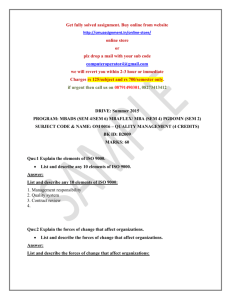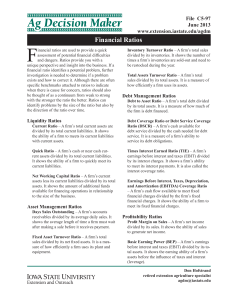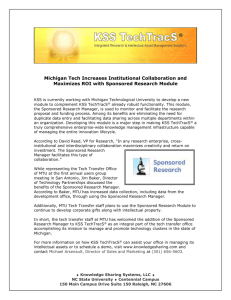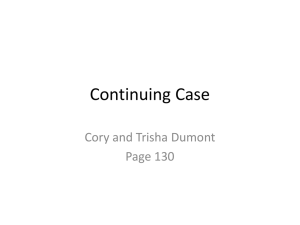Practice test 1 answers
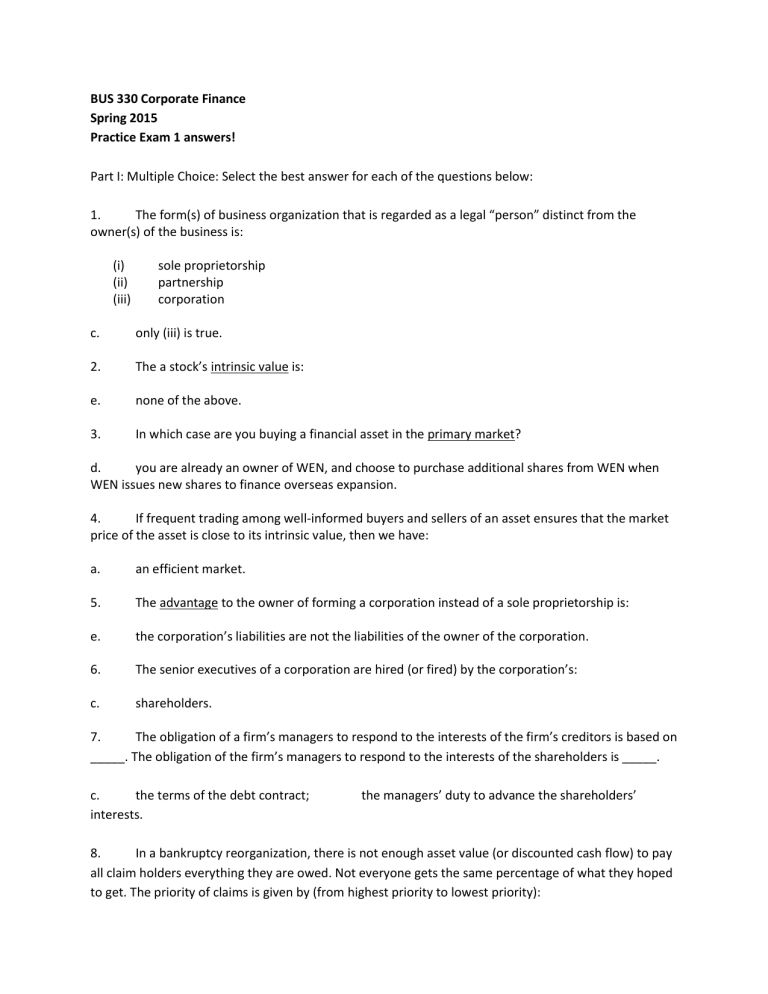
BUS 330 Corporate Finance
Spring 2015
Practice Exam 1 answers!
Part I: Multiple Choice: Select the best answer for each of the questions below: c. e.
6.
7. c.
2.
1. The form(s) of business organization that is regarded as a legal “person” distinct from the owner(s) of the business is:
(i) sole proprietorship
(ii) partnership
(iii) corporation only (iii) is true.
The a stock’s intrinsic value is: e.
3. none of the above.
In which case are you buying a financial asset in the primary market? d. you are already an owner of WEN, and choose to purchase additional shares from WEN when
WEN issues new shares to finance overseas expansion.
4. If frequent trading among well-informed buyers and sellers of an asset ensures that the market price of the asset is close to its intrinsic value, then we have: a. an efficient market.
5. The advantage to the owner of forming a corporation instead of a sole proprietorship is: the corporation’s liabilities are not the liabilities of the owner of the corporation.
The senior executives of a corporation are hired (or fired) by the corporation’s: shareholders.
The obligation of a firm’s managers to respond to the interests of the firm’s creditors is based on
_____. The obligation of the firm’s managers to respond to the interests of the shareholders is _____. c. the terms of the debt contract; interests. the managers’ duty to advance the shareholders’
8. In a bankruptcy reorganization, there is not enough asset value (or discounted cash flow) to pay all claim holders everything they are owed. Not everyone gets the same percentage of what they hoped to get. The priority of claims is given by (from highest priority to lowest priority):
b. secured creditors, unsecured creditors, stockholders
9. Lenders must carefully select borrowers, then design contracts that protect their rights against possible mishaps or abuses on the part of the borrower, and then ensure that the terms of the contract are being fulfilled. If there are many lenders, they must also ensure that the costs of the contract design and supervision are being shared by all lenders proportionately. When the lenders accomplish this by
“hiring” a firm to do this on their behalf – they are using a: a. financial intermediary
10. Some financial ratios are especially useful to analysts or managers who wish to evaluate the operational performance of the company (compared to another company or the industry average), potential lenders, other financial ratios are more useful to a lender who wants to evaluate the ability of a company to meet its debts as they come due. The ____ ratio is an example of the first type of ratio, and the ____ ratio is an example of the second. c. e. total assets turnover inventory turnover debt quick (acid test)
11. The _____ describes how much (and why) a firm’s equity changed during a year. The _____ is the financial statement that describes the firm’s operating performance. The _____ is the financial statement that describes the company’s financial position at a particular date. d. statement of stockholders’ equity income statement balance sheet
12. If a corporation pays 40% of its income as tax (typical in the USA), the amount of pre-tax income needed to fund $6 of dividend payments to shareholders is: d. $10
13. The benefit to a company of adopting accelerated depreciation rather than straight-line depreciation of its assets for reporting its income to the government is: d. the company will be able to postpone paying income tax by using accelerated depreciation – which is like getting an interest-free loan from the government.
Part II: Below are 2 sets of financial statements. One is Target (TGT) which is a US-based retail clothing chain. The other is Kohl’s (KSS), another clothing retailer operating in the same market segment. Answer the following questions, using ratio analysis when and where appropriate to support your analysis:
Balance Sheet
Current Assets
Cash And Cash
Equivalents
Net Receivables
Inventory
Other Current Assets
Total Current Assets
Long Term Investments
Property Plant and Equipment
Other Assets
Total Assets
Liabilities
Current Liabilities
Accounts Payable
Short/Current Long Term
Debt
Total Current Liabilities
Long Term Debt
Other Liabilities
Deferred Long Term Liability
Charges
Total Liabilities
Stockholders' Equity
Common Stock
Retained Earnings
Treasury Stock
Capital Surplus
Other Stockholder Equity
Total Stockholder Equity
Net Tangible Assets
Income Statement
Target (TGT)
695,000
-
8,766,000
2,112,000
11,573,000
-
31,378,000
1,602,000
44,553,000
11,617,000
1,160,000
12,777,000
12,622,000
1,490,000
1,433,000
28,322,000
53,000
12,599,000
-
4,470,000
-891,000
16,231,000
16,231,000
8,400,000
4,000
11,462,000
-8,052,000
2,598,000
-34,000
5,978,000
5,978,000
Kohls (KSS)
971,000
142,000
3,874,000
305,000
5,292,000
64,000
8,745,000
277,000
14,378,000
2,597,000
139,000
2,736,000
4,722,000
560,000
382,000
Period Ending
Total Revenue
Cost of Revenue
1-Feb-14
72,596,000
51,160,000
1-Feb-14
19,031,000
12,087,000
Gross Profit
Selling General and
Administrative
Non Recurring
Others
Operating Income or Loss
21,436,000
15,375,000
-391,000
2,223,000
4,229,000
6,944,000
4,313,000
-
889,000
1,742,000
Earnings Before Interest
And Taxes
Interest Expense
Income Before Tax
Income Tax Expense
Net Income From
Continuing Ops
Net Income
4,229,000
1,126,000
3,103,000
1,132,000
1,971,000
1,742,000
338,000
1,404,000
515,000
889,000
1,971,000 889,000
Net Income Applicable To
Common Shares
1,971,000 889,000
1.
If you are commercial lending officer for Citicorp and both of these chains proposes to negotiate an additional $6 billion in borrowing from your bank in order to finance an expansion, which would you rather lend to (and why).
Answer: there are several ratios you might consult. The current and quick ratios measure liquidity – which is a measure of the company’s short-term adequacy of cash. Using these measures KSS looks better (especially the quick ratio, but perhaps the balance sheet was prepared when TGT had unusually large inventory.)
Probably more important for a large issue of debt (long-term if it is to be used to fund expansion) would be the company’s record of asset management. After all, you are considering giving the company a pile of money to be used to acquire more assets. Is the company any good at using assets?
Here you might want to use the fixed asset turnover ratio:
TGT = 2.3; KSS = 2.2
Not much difference there.
The Basic Earning Power ratio compares the companies’ ability to convert assets into operating income
(from which the lender will need to be repaid).
TGT = 9.5%; KSS = 12.1%
Here KSS looks like they do a better job. (If you compare interest to total liabilities to compute the average cost of debt, it comes out to 4.0% for both companies, so both companies should be able to obtain additional financing.)
The TIE ratio and Debt ratios measure how much of a company’s debt capacity is already used up.
TIE: TGT = 3.8; KSS = 5.2. It looks like KSS has more room to expand debt without running short of earnings.
Debt: TGT = 64%; KSS = 58%. Pretty close, but again KSS could more easily take on more debt.
2.
You are a management consultant for McKinsey specializing in retail businesses. The management of Kohl’s corporation hires you to recommend to them areas in which their performance can be improved that will generate greater shareholder value. What would you recommend?
We just got done saying that it looks like KSS is a better-run company. What could they do better? Note in the answer above that debt costs KSS an average of 4.0% per year. But KSS earns 12.1% on its assets.
Therefore increasing its debt ratio (either by expansion or by using borrowed money to re-purchase shares) means that the extra 8.1% is concentrated as extra return to shareholders.
3.
The P/E (ttm) ratio for Target is 32.1, the forward P/E for Target is 16.8. If earnings per share is
$2.38 and the number of shares outstanding is not expected to change, what earnings per share are projected for next year?
The P in the first P/E is the same as the P in the second. The only difference is in the “E”. If the historical earnings in the P/E (ttm) is 2.38, we have:
P/2.38 = 32.1 so P = 76.40. In the second ratio we have 76.40/E fwd
= 16.8. Therefore E fwd
= 76.40/16.8 =
$4.55.
4.
What would you examine to see if you think the earnings projection (above) for Target is achievable? Is it? (Explain).
Whoever is publishing that forward P/E is claiming that TGT earnings will rise from 2.38 last year to 4.55 per share in the coming year. Is that realistic? We see from the ratios above that TGT did not perform as well last year as at least one of its competitors. The profit margin of TGT was 2.7% compared to KSS at
4.7%. If earnings rise as much as predicted, then the profit margin of TGT would need to rise to
(4.55/2.38) x 2.7% = 5.1%. Can TGT overtake the profit margin of KSS in one year? Maybe (if last year was a particularly bad year for TGT for some short-term reason… maybe). On the other hand, maybe not.


